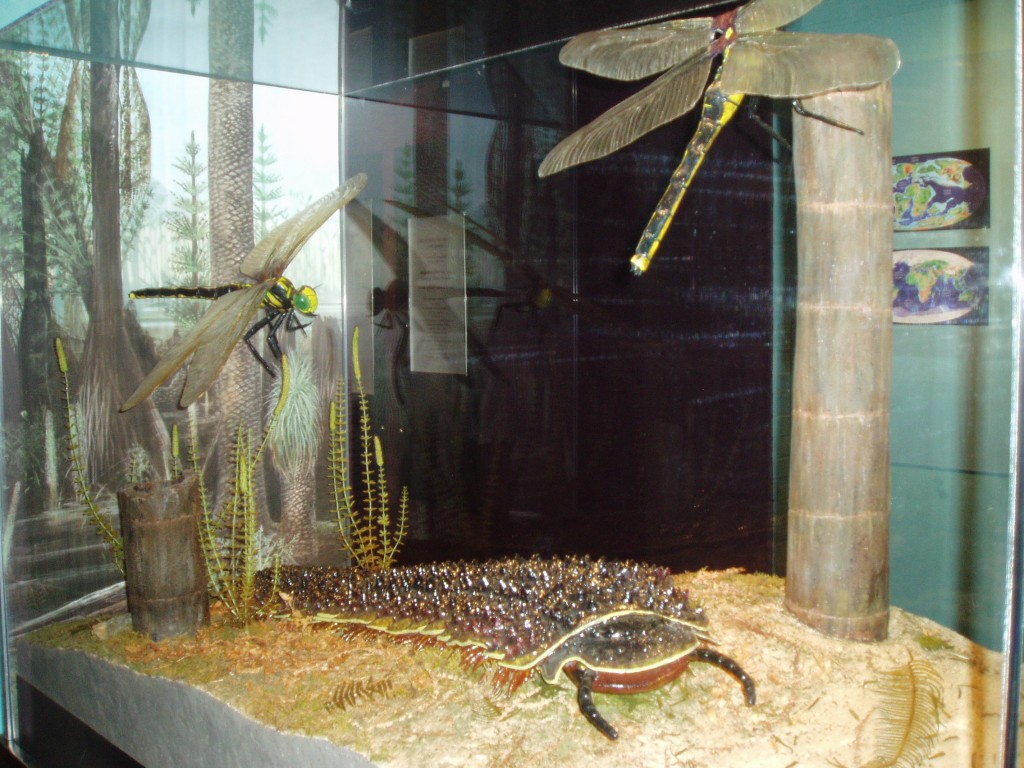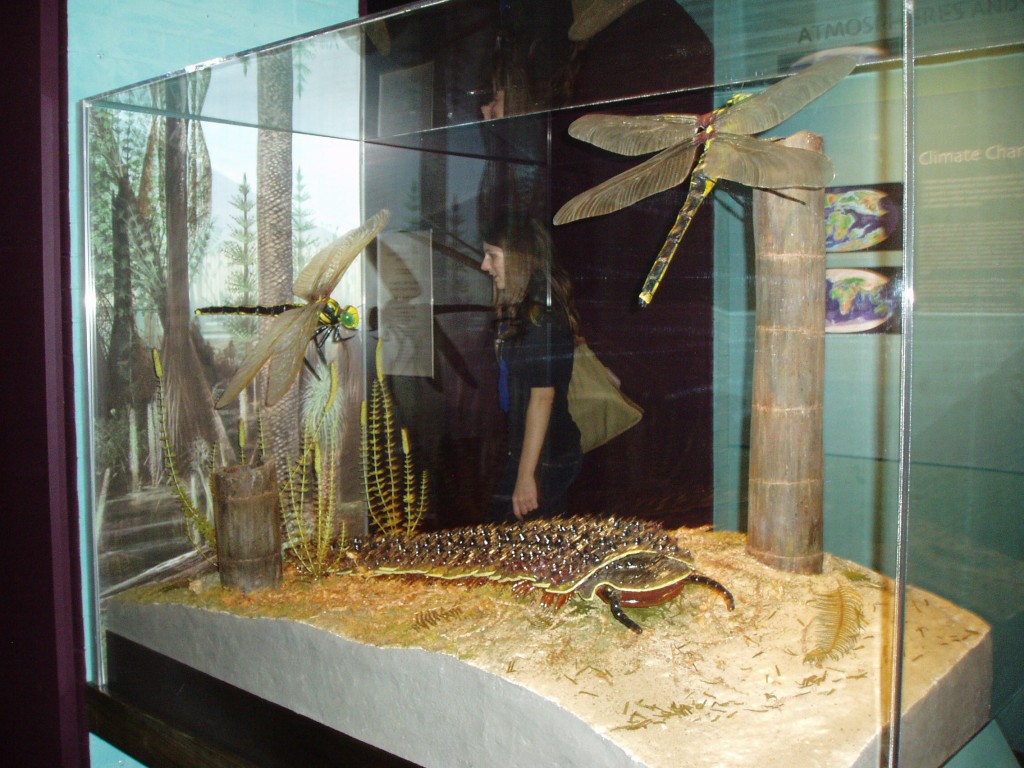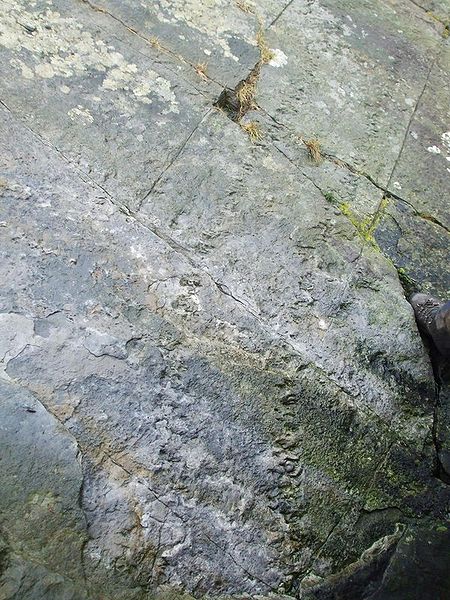I am in New Haven for the 2010 meeting of the National Association of Science Writers. At the schmoozing soiree tonight at the Yale-Peabody Natural History Museum, I encountered two wonderful things. 1: the famous Age of Reptiles Mural* that imprinted the image of a stiffly lumbering yet truly frightening (the eye! the horrible eye!) T. rex into many an eight-year-old’s mind, and this:
To give you a better feel for the size of this thing, here is a version with a person in it:
This amazing millipede relative is likely the largest land invertebrate ever found on Earth (or rather, fossilized and found by humans on Earth, since without records we’d never know if there were bigger). It evolved during the Carboniferous period 300 million years ago, the era of rampant plant growth long before the age of the dinosaurs (250 mya) or even of reasonably efficient herbivores of any sort, which resulted in the vast deposits of coal that are powering our economy (and filling up our atmosphere with carbon dioxide) now.
In that time, without roving herds of plant-obliterating machines, and with the help of nice, wet, monsoon-on-steroids conditions, plants went crazy, and grew so fast they were buried in swamps faster than they could decay. Without a good rot, the carbon locked inside plants by photosynthesis as cellulose and friends never made it back into the atmosphere as carbon dioxide (it ended up getting pressed into coal), and oxygen’s share in the atmosphere increased to 25-30% (it is 21% now). Because most land invertebrates are encased in a gas-impermeable shell and don’t possess gills or big baggy, lacy lungs, many must breathe by simple diffusion through little tubes or pores in their bodies. They are very limited by the lack of surface area and circulation in this system of gas exchange, and simply can’t get any bigger than diffusion rates allow.
With waaaay more oxygen in the air, diffusion worked better and they could get bigger. How big? Well, this millipede relative, Arthropleura, could reach eight and a half feet. Eight and a half feet of undulating, creepy-crawly, armor-plated, and possibly envenomated goodness. Think about that. And now think about what it might have been like at night.
Arthropleura is a myriapod, a kind of arthropod, but not an insect — see this post for a nice graphic showing relative position in the tree of life. No one has ever found the fossilized jaws of this thing (Am divided on whether this is good or bad). Scientists originally supposed it was a vicious predator, but the discovery of fern spores in its fossilized gut may indicate it was a big dumb plant eater. As with tootsie pops, the world may never know. Perhaps even more astoundingly, like many dinosaurs, we actually have fossil trackwaves of Arthropleura feet. Here’s one from Britain:
[Pause for reflection] I, for one, am glad 100% of land invertebrates are theoretically squishable by me, a 105-pound human, today. That is all.
__________________________________
*I also grew up with images of stiff, upright dinosaurs, yet most current youngsters, raised (or born into) the Jurassic Park era, must see this painting as unimaginably (and ironically, considering they are of extinct animals) archaic. I stepped back to take wider look at the immense mural — and though it was outdated, I must say it is still beautiful beyond belief. It glows with a dewey freshness even after 60 years. And though its vertebrate subject matter seems patently fake now, the plants, the cliffs, and the sunset glow in the sky and water at far right seem like they could have been captured somewhere in Utah just yesterday. This probably reflects the artist’s choice of the renaissance fresco secco technique, which lends the same still-bright-after-500-years jewel-toned glow to many Italian renaissance egg-tempera paintings found in art museums around the world today.





{ 1 trackback }
{ 4 comments… read them below or add one }
Jen, this post is funny, informative, and beautifully written. Thanks for sharing your trip with us!
Jess
Hey, Jen,
Sweet post. The higher oxygen content of the atmosphere in the Carboniferous undoubtedly helped the arthropods do their over-sized thing, but it has been shown that insects can actively pump air through their tracheae.
http://en.wikipedia.org/wiki/Invertebrate_trachea
http://www.sciencemag.org/cgi/content/abstract/299/5606/558
Good to know! Didn’t learn about that back in Entomology 101 at Cornell, but that was back in the Stone Age of the late ’90s . . . : )
jf
Dear Jennifer — I met you at the Yale meeting. I too had your reaction when I first saw the mural. It was the latest thing in dinos when I was a kid in the fifties. I think, if I remember correctly, that the mural was recently cleaned and/or refurbished etc. What did you think of the giant turtle-thing hanging on the wall. Its bigger than a kind-sized bed!